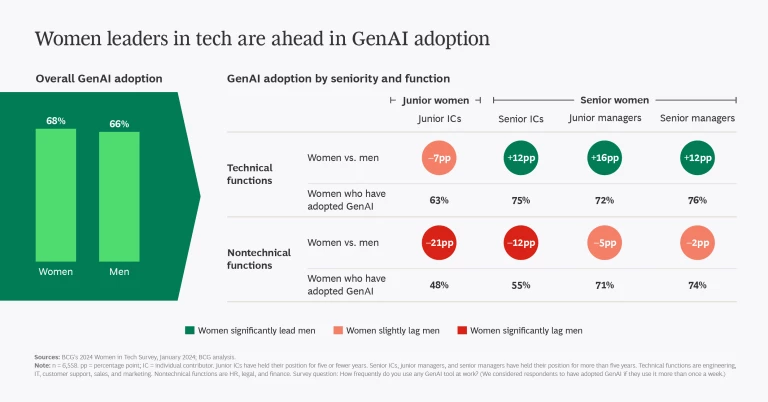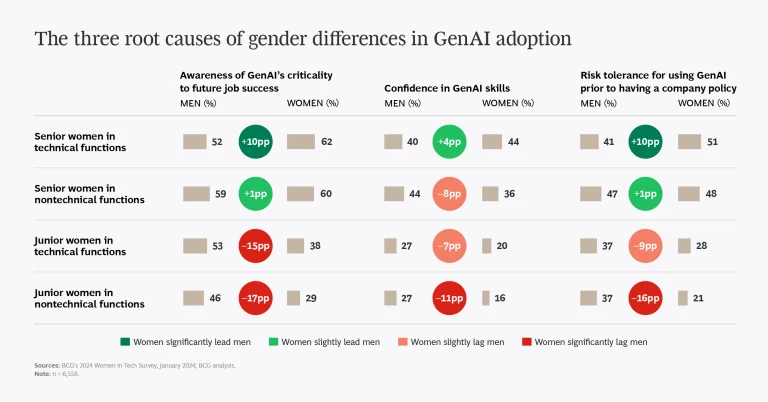Generative AI (GenAI) is proliferating rapidly, and C-suite executives across industries expect that, on average, 46% of workers will need to be reskilled in the next three years as a result. In the technology industry specifically, our new BCG survey shows that 55% of workers across various roles think that GenAI will be critical to their job success.
Women have historically been less likely to adopt new technologies than men have, especially in the early days. For instance, a 2020 YouGov report found that less than 40% of early tech adopters among consumers were women. If the adoption of GenAI follows a similar trend, there is a risk that the gender gap in the tech industry will widen further, as fewer than 30% of middle managers and senior leaders in tech today are women . Now more than ever, companies need to be hyperfocused on proactive measures that minimize and ultimately reduce this gap.
To determine if there are gender differences in adopting GenAI and if so, the root causes and the paths to a resolution, BCG conducted a global survey of more than 6,500 women and men employees in tech companies across seniority levels and functions. In addition, 15 women leaders in the tech industry provided their insights and views on a pathway forward. (See the sidebar “Our Methodology.”)
Our Methodology
Gender Differences in GenAI Adoption
In contrast to historical trends, women respondents to BCG’s tech industry survey are generally on a par with their men peers in terms of GenAI adoption. In fact, 68% of women in the industry said they use a GenAI tool at work more than once a week, compared with 66% of men.
However, we found significant differences by seniority and function.

All senior women in technical functions are ahead. Senior women in technical functions—engineering, IT, customer support, sales, and marketing—are ahead of their men counterparts in adopting GenAI. These senior individual contributors (ICs), junior managers, and senior managers lead their men peers by an average of 14 percentage points (pp).
These findings reveal a chance for senior women in the tech industry “to lead and shape the GenAI revolution,” according to a woman director of a large AI company, and thus potentially contribute to improving women’s representation in tech leadership.
The greater the seniority of women leaders in nontechnical functions, the less the lag. Women senior managers in nontechnical functions (HR, legal, and finance) are trailing their men peers by only 2pp, while women junior managers and senior ICs are behind by 5pp and 12pp, respectively. Despite the near parity for women and men senior managers, the pipeline could be vulnerable, posing a risk of losing today’s relatively high representation of women (albeit often in junior roles) in nontechnical functions. (Women make up 50% to 75% of the US workforce in finance, legal, and HR functions, according to a 2023 report from the US Bureau of Labor Statistics.)
Junior women in technical functions lag their peers. Women junior ICs in technical functions trail their men peers by an average of 7pp, a situation that could potentially worsen the pipeline issues already prevailing in many tech companies. “We already have a pipeline problem in tech,” notes the woman director of a large e-commerce company, “and despite our efforts, we’re losing women between the IC and manager levels.”
Junior women in nontechnical functions are the furthest behind. Women junior ICs in nontechnical functions lag the most in adoption by 21pp. The lag for this group and for women senior ICs in these same functions adds to the risk of losing gains in representation as GenAI continues to affect roles and career success.
The Root Causes
What explains the gender differences in GenAI adoption? As the exhibit below shows, three key attributes (out of five that we studied) drive the differences: awareness of GenAI’s criticality for future job success, confidence in GenAI skills, and a person’s tolerance for risk when their company’s GenAI policy is unclear. We found that men and women had similar perspectives on the other two attributes: trust that GenAI tools would accomplish their objectives and feelings of competence in using GenAI tools.

Awareness of GenAI’s Criticality. Awareness is a key driver of adoption. Compared with men, senior women are similarly or even more aware of the potential impact of GenAI on job success, while junior women are less aware. In fact, senior women in technical functions are 10pp ahead of their men peers in those functions. Their attitude may correlate with the perceived pressure to overperform in an industry largely occupied by men. As a woman CIO of a semiconductor company notes, “[Senior women in tech] have broken barriers to get where they are, but they still feel they need to prove themselves and take more initiative than men to be abreast with what’s important for their careers [such as GenAI].”
Senior women in nontechnical functions similarly seem to be looking ahead, as they are almost on a par with their men counterparts. “Even in nontech functions,” a woman board member of an IT services company explains, “as you get more senior, you’re in the right rooms and know what will be important in the future.”
In contrast, junior women are behind their men peers in both function types (15pp behind in technical functions and 17pp behind in nontechnical functions). And they trail senior women as well, by 24pp and 31pp in technical and nontechnical functions, respectively. By comparison, junior men in technical functions are on a par with senior men in those functions and only 13pp behind senior men in nontechnical functions. The finding that all men are at a similar level of awareness about GenAI’s criticality for future job success and that this is not the case among women is concerning. Two reasons we have observed are that junior women do not have the same access to the networks and discussions where GenAI strategy is formed as do junior men and that they are not equally represented in GenAI pilots and initiatives.
Confidence in GenAI Skills. Senior women in technical functions are ahead of their men colleagues by 4pp in their GenAI confidence levels, while senior women in nontechnical functions lag their men peers by 8pp, and junior women in all functions are behind—by 7pp in technical functions and 11pp in nontechnical functions.
This lack of confidence is the only attribute in our research that explains why senior women in nontechnical functions, who are aware enough and senior enough to understand that GenAI will be critical to their future success, lag their men colleagues in GenAI’s adoption. We posit that these senior women, starting at a lower technology-skills confidence level, may not have had the time needed to experiment with GenAI and build that confidence. According to a woman CEO of a multinational SaaS company, “I have observed that working women with kids don’t generally have time to experiment out of pure intellectual interest; there needs to be a clear practical application for them to engage.” This is one explanation of many that could be a contributing factor to the greater demands on their time.
While there may be several reasons for junior women’s lack of confidence in their GenAI skills, research has shown that perception and exposure challenges exist for women in arenas largely occupied by men. For example, a 2018 Pew Research Center poll found that women in science, technology, engineering, and math (STEM) jobs were over seven times more likely than men to be treated as if they were not competent. And a December 2023 Gallup study observed that women of all ages have been significantly less exposed to STEM topics in school, especially computer science.
Tolerance for Risk. Senior women report a risk tolerance equal to or greater than their men peers in both technical and nontechnical functions, while junior women lag relative to their men peers (by 9pp in technical functions and 16pp in nontechnical functions).
By virtue of having broken barriers to get where they are today, senior women have learned how to take risks in order to succeed in their work. In contrast, junior women in technical functions may feel less at liberty to experiment, particularly when dealing with nascent technologies. As a woman director of a large AI company explains, “Junior women in tech may be more concerned than men about the limits and risks of GenAI tools.”
For junior women in nontechnical functions, a woman vice president of a large enterprise-technology company observes, “[Junior women in nontech roles] may be less likely to take risks without clear policies [in place], and limited tech know-how is an additional barrier.”
A Path Forward
GenAI offers the opportunity to reduce the gender gap in the tech industry if managed correctly. But it requires action by both companies and the women who work for them. Companies that are ready to pilot and scale GenAI can reduce the gender gap in the tech industry by tackling the three key root causes of gender differences—awareness of GenAI’s criticality, skills-related confidence, and tolerance for risk. In addition, women can capture the opportunity by proactively engaging and experimenting with GenAI.
Leadership Advocacy and Change Management. To increase awareness of the importance of GenAI, leadership can advocate its use while connecting it to the overall business strategy and setting clear expectations that its use is a priority. “What leaders shine a light on is what’s important,” notes a woman board member of an IT services company. “Leaders need to recognize and elevate [working with GenAI] such that people are excited to do it.”
A key part of successful leadership advocacy will be introducing change management initiatives that support and reward the adoption of GenAI while acknowledging women who are GenAI champions. Another will be specifically elevating women to lead GenAI projects so that they inspire others and serve as role models.
We also recommend establishing a clear communications strategy designed to show how GenAI will help employees succeed, including sharing employees’ success stories, such as how an individual used it to improve productivity.
Targeted Upskilling Programs. Building confidence will require a significant investment of time in learning how to use GenAI. As a result, employers can design upskilling programs that are highly targeted to the function and role of employees and include the presentation of specific use cases. Our experience shows that companies can also benefit from building in dedicated time for all employees to learn new skills through experimentation.
In addition, businesses can set up communities of practice—networks of individuals with shared interests and capabilities—to allow employees in similar functions to discuss lessons and use cases in targeted, real-time sessions, boosting the confidence of those who attend and creating a stronger network where one may not organically exist.
Robust Pilot Design and Clear Responsible AI Policies. Addressing gender differences in risk tolerance is more nuanced, compared with the approaches to other root causes. Doing so will require businesses to develop a robust pilot or a sandbox environment that offers a safe space for employees to explore and test GenAI tools. This test environment should include clear responsible AI guardrails and policies, translated into actionable advice for employees. This environment should also increase comfort levels for everyone, regardless of their tolerance for risk.
When designing the pilots, businesses need to ensure that the pilots are led by and include diverse groups of employees, handpicking those who will participate to give multiple groups the opportunity to study and test GenAI. And businesses should create a mechanism for ensuring that pilot participants share the GenAI benefits they experienced with their peers. These steps will tremendously improve trust in GenAI tools as well as risk tolerance levels related to using them.
Proactive Career Management. While our results indicate that GenAI offers the opportunity to reduce the gender gap in the tech industry, achieving that goal will depend not only on corporate actions but also on those taken by women on their own behalf. Women, for example, can seek out their own upskilling opportunities and volunteer for GenAI-related initiatives and leadership opportunities. As a woman board member of an IT services company says, “There is also a lot that women can take into their own hands, including proactively learning and experimenting with GenAI themselves.”
Next Steps
Companies can begin to generate outsize impact today by targeting their actions to individual cohorts. Taking these steps will not only go far toward increasing equity in GenAI’s adoption but also support all employees’ adoption of GenAI.
- Demonstrate the importance of GenAI, provide direct training opportunities, and supply pragmatic advice on the safe use of AI in the relevant work context.
- Elevate senior women in technical functions to the leadership of GenAI pilots and initiatives, setting them up to establish the GenAI agenda and inspire junior women.
- Demystify for senior women in nontechnical functions how GenAI can help them in their work, building time into their agendas to take advantage of dedicated sessions to learn and experiment.

















